HP Pavilion 17 (17-ab300) review – fairly priced 17-inch all-rounder
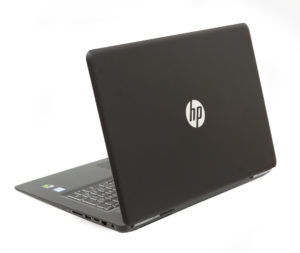 More than a year ago we showed you a device, that could challenge larger, more expensive devices in the gaming segment, thanks to its competitive hardware and low price. A year and a half later nothing has changed. The new HP Pavilion 17 – (17-ab300), still has a good configuration of a fast Kaby Lake CPU – Core i7-7700HQ, and a good mid-range GPU – GeForce GTX 1050 Ti. Once again the device is equipped with an IPS panel.
More than a year ago we showed you a device, that could challenge larger, more expensive devices in the gaming segment, thanks to its competitive hardware and low price. A year and a half later nothing has changed. The new HP Pavilion 17 – (17-ab300), still has a good configuration of a fast Kaby Lake CPU – Core i7-7700HQ, and a good mid-range GPU – GeForce GTX 1050 Ti. Once again the device is equipped with an IPS panel.
Continuing with the similarities with the older model, this one also has a plastic body, which is very flexible (not in a good way). Yet we have to mention that if you are into gaming or you’re a multimedia freak, this is one of the cheapest 17-inch options out there, so you have to expect some drawbacks. One of which is also the cooling which, as you are will see in our temperature section, doesn’t quite have the capacity to properly cool the device.
You can find the prices and configurations in our Specs System: http://laptopmedia.com/series/hp-pavilion-17-17-ab300/
Contents
Specs Sheet
The current specs sheet is for this particular model and configurations may differ depending on your region.
HP Pavilion 17 (17-ab300) technical specifications table
What’s in the box?
Inside the package, there are a couple of ingredients: one pinch of documentation, two sheets of a computer, and one stick of a charging device. The latter is a hefty one – 150 W to be precise.
Design and construction
The HP Pavilion 17 (17-ab300) is nothing impressive in terms of design. A 17-inch form factor in a black-painted polycarbonate shell. The Pavilion 17 doesn’t boast a thin construction with its 29.9 millimeters. The device measures at 416 x 279 x 299 mm (16.4 x 10.98 x 1.18 inches). This year’s model is a bit lighter than the previous one – 2.85 kg vs the 3.1 kg from the latter. It’s worth noting that the removable 62-Wh battery significantly contributes to the weight of the computer.
Opening the lid of the laptop, we are met by some squeaking from the plastic material. The hinges are a bit shaky but what we like about them is the design, similar to those of a door in an old Italian mansion. Furthermore, we also like the styling of this part of the device. The combination of black color and white accent under around each key of the keyboard is enhanced by the green, from NVIDIA’s sticker.
Speaking of the keyboard, it’s not the best on the market but the feedback it gives is nice. Sadly it lacks a backlight, although the white paint can lead you to think, that it is equipped with this feature. Another thing we are not really impressed with is the layout of the arrow keys. Why HP?! Similarly to the ProBook 470 G5 we reviewed for you earlier, the up and down arrow keys are half-sized… on a 17-inch device (Error 404, no excuses found).
The touchpad here is of a good size – neither too small, nor too big to get in the way. On the opposite side of the keyboard is located the speaker grill, which both looks good and has a nice front-facing location, although the actual speakers take a minor part from the whole grill (more lies, HP).
HP have not flooded the Pavilion 17 (17-ab300) with ports but it has all you need – two USB Type-A ports (one 2.0, and one 3.0) plus a headphone/mic jack on the left. Also here is located the DVD drive – a rarely seen feature these days. In addition to that, there is one more USB 3.0 port, an SD card reader, full-size HDMI port, RJ-45 connector, and the charging socket – a little busier right side. In the top right corner of the device are also the exhaust vents, while the air intake holes are on the bottom panel. From the images below you can also see the large butt of the Pavilion 17.
Display quality
HP Pavilion 17 (17-ab300) has a Full HD screen with an IPS panel. With a size of 17.3 inches, it has a resolution of 1920 x 1080, which gives a pixel density of 127 ppi and a pitch of 0.1995 x 0.1995 mm, making the screen “Retina” when viewed from more than 69 cm. As a matter of fact, this laptop shares the same screen with models like ASUS GL703V, Acer Aspire 5 (A517-71G), Lenovo Legion Y920 and some others, which have a different specification of this panel.

HP Pavilion 17 (17-ab300) has comfortable viewing angles, as you can see from the images below.

The screen of the Pavilion 17 has a pretty high maximum brightness of 409 nits in the middle of the screen and 385 nits average for the whole area, with a maximum deviation of 13%. The Correlated Color Temperature on a white screen is 6960K – a little colder than the optimal for the sRGB standard of 6500K. The average color temperature through the grey scale before profiling is 6850K.
In the illustration below you can see how the display performs from uniformity perspective. In other words the leakage of light from the light source.
Values of dE2000 over 4.0 should not occur, and this parameter is one of the first you should check if you intend to use the laptop for color sensitive work.
The contrast ratio of the panel is 1180:1 (1120:1 after profiling).
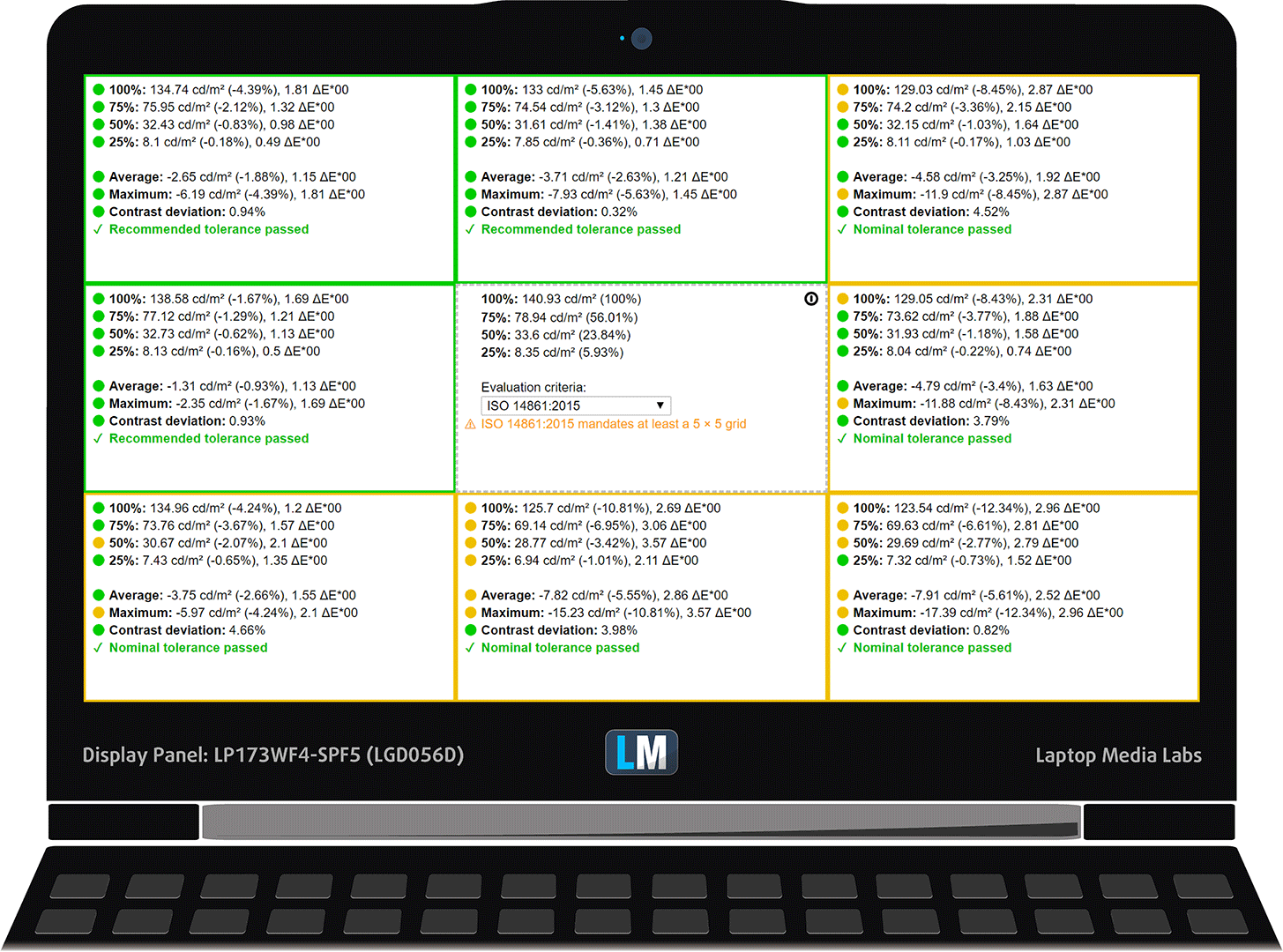
The next image shows the sRGB coverage of HP Pavilion 17 (17-ab300)’s display. The color reproduction of the human eye is shown via the “CIE 1976 Uniform Chromaticity Diagram”. In the middle of the dark-grey triangle are located the standard colors used by Internet and digital TV – rec.709/sRGB.
Being used by million people around the world the colors from the sRGB gamut are the most common and their accurate reproduction is of key importance for the quality of the screen.
In addition to the Adobe RGB color space, used in the professional photography, we’ve included the color gamut, used by world-known movie studios – DCI-P3, and UHD-digital television (Rec.2020), which is very hard to achieve by modern display units.
We have drawn the Pointer’s Gamut with a black line. This color space covers all the colors we can see around us.
The coverage of HP Pavilion 17 (17-ab300) is shown by the yellow pointed line. Its display covers 88% of the sRGB gamut of sRGB/ITU-R BT.709 (web/HDTV standard) in CIE1976.

Our “Gaming and Web design” profile is designed to show optimal color temperature (6500K) when the luminance is at 140 nits and sRGB gamma.
In order to test the display, we used 24 color samples, consisting of common founded and easy distinguishable ones like light and dark human skin, blue sky, grassy green and orange.
Below you can compare the scores of HP Pavilion 17 (17-ab300) with the default settings (left), and with the “Gaming and Web design” profile (right).
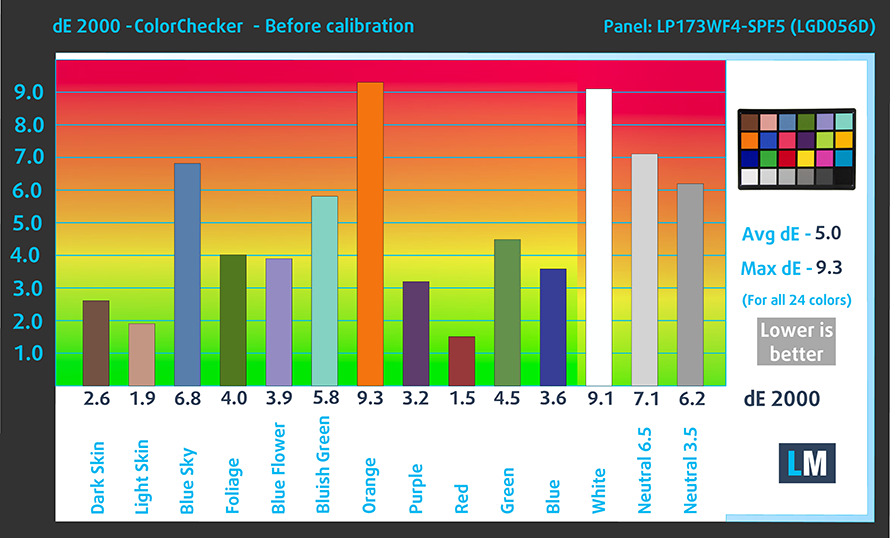
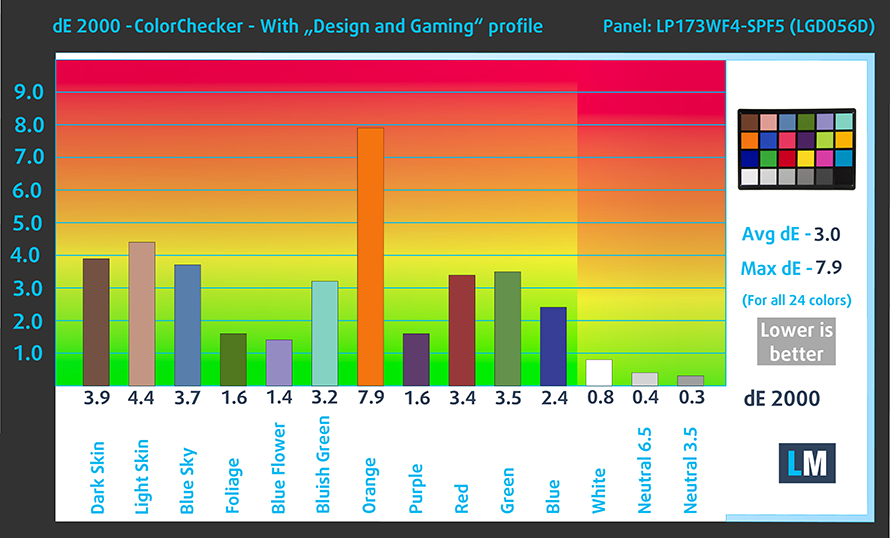
The next chart shows us the capabilities of comfortable gaming experience in terms of the darkest parts of the image.
The left side tells us the default settings results of the screen, and the right one shows us the results with “Gaming and Web design” profile installed. The horizontal gives us the levels of grey, and the vertical one – the screen brightness.
You can check how your device displays the first five levels of grey – 1% – 5% White – via the graphics below the charts. The image you see depends on several factors such as the panel of the display you’re currently reading this article on, it’s calibration, your vision, ambient light, viewing angle and more.

Response time (Gaming capabilities)
The chart below illustrates the response time of the pixels going from Black to White and around for levels of 10% to 90% and vice versa. We measured Fall Time + Rise Time = 28 ms, which is not really bad for an IPS panel.
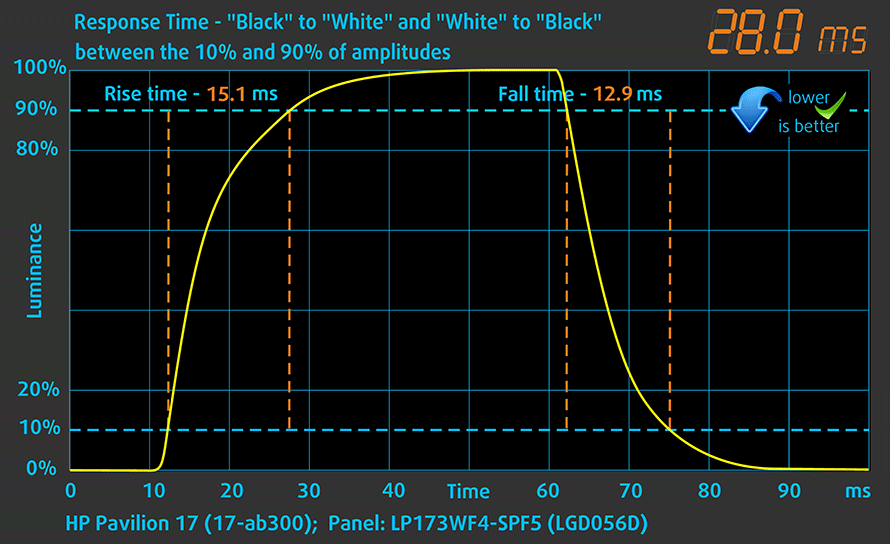
PWM (Screen flickering)
Pulse-width modulation (PWM) is an easy way to control monitor brightness. When you lower the brightness, the light intensity of the backlight is not lowered, but instead turned off and on by the electronics with a frequency indistinguishable to the human eye. In these light impulses, the light/no-light time ratio varies, while brightness remains unchanged, which is harmful to your eyes. You can read more about that in our dedicated article on PWM.
Fortunately, the brightness of the HP Pavilion 17 (17-ab300) is not PWM-adjusted at any levels, providing comfort to the eyes in this aspect. Yay!

Blue light emissions
Installing of our Health-Guard profile not only eliminates PWM but also reduces the harmful Blue Light emissions while keeping the colors of the screen perceptually accurate. If you’re not familiar with the Blue light, the TL;DR version is – emissions that negatively affect your eyes, skin and your whole body. You can find more information about that in our dedicated article on Blue Light.
Conclusion
The display of HP Pavilion 17 (17-ab300) has a Full HD panel with a very good legibility in direct sunlight, nice contrast ratio and viewing angles, and 88% coverage of sRGB/ITU-R BT.709 in CIE1976.
Buy our profiles
Since our profiles are tailored for each individual display model, this article and its respective profile package is meant for HP Pavilion 17 (17-ab300) configurations with 17.3″ LG LGD056D (Full HD, 1920 x 1080) IPS screen: Buy from Amazon.com (#CommissionsEarned)
*Should you have problems with downloading the purchased file, try using a different browser to open the link you’ll receive via e-mail. If the download target is a .php file instead of an archive, change the file extension to .zip or contact us at [email protected].
Read more about the profiles HERE.
In addition to receiving efficient and health-friendly profiles, by buying LaptopMedia's products you also support the development of our labs, where we test devices in order to produce the most objective reviews possible.

Office Work
Office Work should be used mostly by users who spend most of the time looking at pieces of text, tables or just surfing. This profile aims to deliver better distinctness and clarity by keeping a flat gamma curve (2.20), native color temperature and perceptually accurate colors.

Design and Gaming
This profile is aimed at designers who work with colors professionally, and for games and movies as well. Design and Gaming takes display panels to their limits, making them as accurate as possible in the sRGB IEC61966-2-1 standard for Web and HDTV, at white point D65.

Health-Guard
Health-Guard eliminates the harmful Pulse-Width Modulation (PWM) and reduces the negative Blue Light which affects our eyes and body. Since it’s custom tailored for every panel, it manages to keep the colors perceptually accurate. Health-Guard simulates paper so the pressure on the eyes is greatly reduced.
Get all 3 profiles with 33% discount
Sound
HP Pavilion 17 (17-ab300) pumps a really nice sound with clear low, mid, and high frequencies.
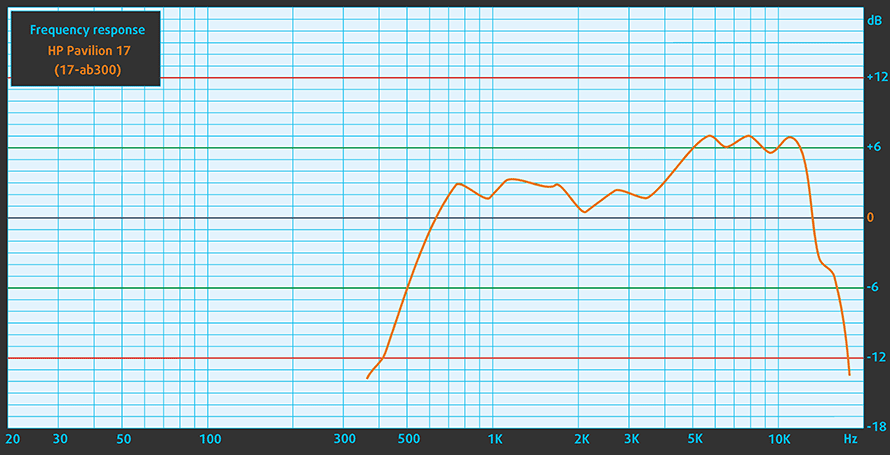
Software
HP Pavilion 17 (17-ab300) comes with 64-bit Windows 10 Home edition. In case you need to reinstall your system, you can get the drivers from here: https://support.hp.com/us-en/drivers/selfservice/hp-pavilion-17-ab300-notebook-pc/18149533
Battery
As always, the battery tests were run with Windows power saving setting turned and Wi-Fi turned on, and the screen brightness adjusted to 120 nits. The 6-cell 62-Wh battery would be enough for almost 6 hours of Web surfing and Video playback. Which is not bad for this size of a device, and keeping in mind that the hardware is not the most energy efficient. However, if you want to take advantage of the GeForce GTX 1050 Ti, you wouldn’t want to stay away from the charger, since you’ll only get just over an hour.
CPU – Intel Core i7-7700HQ
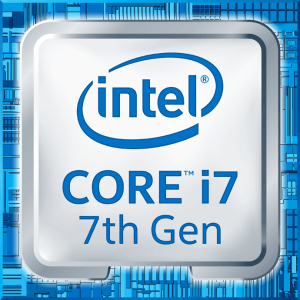 The Core i7-7700HQ is Kaby Lake’s top-shelf direct successor of the Skylake Core i7-6700HQ offering slightly higher clock speeds on the almost identical architecture and TDP. While Intel markets Kaby Lake’s architecture as “14nm+”, the Core i7-7700HQ is still on the same 14nm node with the only significant update being in the iGPU department. That’s why the slightly altered clock speeds (2.8 – 3.8 GHz vs 2.6 – 3.5 GHz) bring not more than 10% increase in performance compared to the Core i7-6700HQ. We still have the supported Hyper-Threading technology with 4/8 – core/thread design, the same 45W TDP and 6MB cache.
The Core i7-7700HQ is Kaby Lake’s top-shelf direct successor of the Skylake Core i7-6700HQ offering slightly higher clock speeds on the almost identical architecture and TDP. While Intel markets Kaby Lake’s architecture as “14nm+”, the Core i7-7700HQ is still on the same 14nm node with the only significant update being in the iGPU department. That’s why the slightly altered clock speeds (2.8 – 3.8 GHz vs 2.6 – 3.5 GHz) bring not more than 10% increase in performance compared to the Core i7-6700HQ. We still have the supported Hyper-Threading technology with 4/8 – core/thread design, the same 45W TDP and 6MB cache.
However, the Kaby Lake generation boasts an updated video engine for the iGPU, although, its performance is just about the same. Branded as Intel HD Graphics 630, the GPU offers slightly higher clock speeds (350 – 1100 MHz vs 350 – 1050 MHz) compared to the Intel HD Graphics 530 and support for H265/HEVC Main10 profile at 10-bit color depth and the VP9 codec for full hardware acceleration. In addition, the HDCP 2.2 is also supported allowing Netflix’s 4K video streaming.
You can browse through our top CPUs ranking: http://laptopmedia.com/top-laptop-cpu-ranking/
GPU – NVIDIA GeForce GTX 1050 Ti (4GB GDDR5)
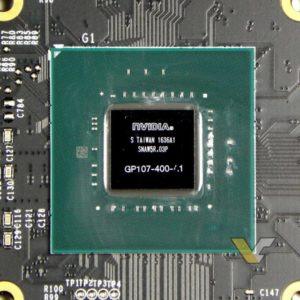 NVIDIA’s GTX 1050 Ti for notebooks is almost identical to its desktop counterpart but offers different clock rates. What’s more, the Ti variant uses more CUDA cores than the standard GTX 1050 version – 768 vs 640 but both GPUs use the same GP107 chip, which differs from the other NVIDIA high-end solutions. The GP107 chip is manufactured by Samsung, not TSMC, and it’s built on the 14nm node on contrary to the 16nm from TSMC.
NVIDIA’s GTX 1050 Ti for notebooks is almost identical to its desktop counterpart but offers different clock rates. What’s more, the Ti variant uses more CUDA cores than the standard GTX 1050 version – 768 vs 640 but both GPUs use the same GP107 chip, which differs from the other NVIDIA high-end solutions. The GP107 chip is manufactured by Samsung, not TSMC, and it’s built on the 14nm node on contrary to the 16nm from TSMC.
Anyway, the GTX 1050 Ti also offers significantly higher clock rates than the normal GTX 1050 versions well 1493 – 1620 MHz vs 1364 – 1493 MHz. This contributes to a significant performance boost over the standard version but the rest of the specs remain the same. The GPU offers 4GB of GDDR5 memory connected via 128-bit interface and transfer rates as high as 112 GB/s.
You can browse through our top GPUs ranking: http://laptopmedia.com/top-laptop-graphics-ranking/
Storage performance
In order to test the agility of HP Pavilion 17 (17-ab300)’s SSD, we used the trusty CrystalDiskMark benchmark. The results here are nothing extraordinary – 530.4 MB/s Read speeds and 499.7 MB/s Write, corresponding to the SATA nature of the drive.

Gaming tests

| Far Cry Primal | Full HD, Normal (Check settings) | Full HD, High (Check settings) | Full HD, Very High (Check settings) |
|---|---|---|---|
| Average FPS | 57 fps | 48 fps | 43 fps |

| Rise of the Tomb Raider (2016) | Full HD, Low (Check settings) | Full HD, Medium (Check settings) | Full HD, Very High (Check settings) |
|---|---|---|---|
| Average FPS | 67 fps | 45 fps | 31 fps |
Temperatures
The temperature tests go this way. We use Prime95 and FurMark to torture the CPU and the GPU respectively. This won’t give real-life representation but with our methodology, we try to give you the most optimal results.
The first values from the test are from the 30th second of running the Prime95 stress test, which simulates a heavy task run on your computer (usually lighter tasks take from a part of the second up to a couple of seconds). Next, we take the ones from the 2nd-minute mark, which imitates a very heavy task, run on the CPU. The last values we give you are the ones at the end of the test, which is 15 minutes, simulating the CPU load when rendering a video, for example.
0-15 min. CPU torture test
HP Pavilion 17 (17-ab300)’s Core i7-7700HQ has a base frequency of 2.8 GHz, that goes up to 3.8 GHz in turbo mode. This CPU’s maximum TDP is rated at 45W. Before we started the test we measured 40°C of idle temperature on the CPU. 30 seconds into the test we already had information about the potential of this device’s cooling solution. Its core speeds fluctuated between 3.1 and 3.4 GHz, resulting in an average of 3.3 GHz for this time period. Temperature-wise, we got up to 84°C, with an average of 80°C.


The next checkpoint is at the 2nd-minute mark… and ladies and gentlemen – Thermal Throttling. The frequencies went down to 3.00 GHz flat after around 35-40 seconds of torture, while the temps maintained the previous 80°C average.


For the rest of the torture session, we saw a fluctuation between 2.9 GHz and 3.1 GHz, and the temperatures were around 85-86°C, which in our opinion is not very good, given the size of the device, and the huge potential the space inside offers. However, a 400 MHz of throttling for 15 minutes of 100% stress of the CPU is not terrible, so you can be confident that the Core i7-7700HQ inside this machine is more than capable to push through a video rendering session without any problems.
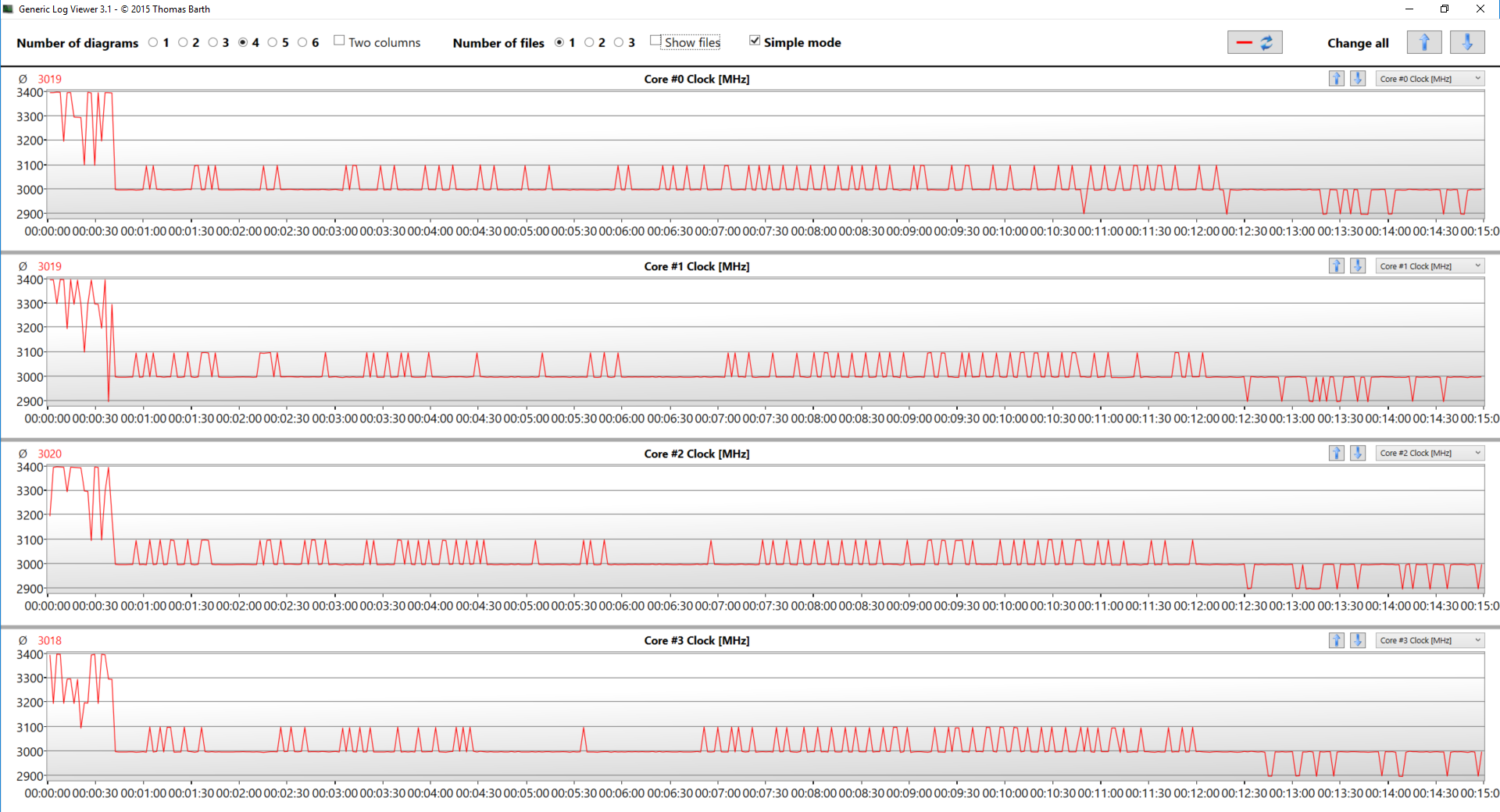

30 min. GPU torture test
Moving to the NVIDIA GeForce GTX 1050 Ti inside this machine. It’s worth mentioning that this GPU is part of the Pascal line of graphics solutions. We are mentioning the obvious here because of the power efficiency of this generation of graphics cards from NVIDIA. Here, not only did it not suffer from thermal throttling, but it also achieved speeds of around 1690 MHz throughout the whole 30-minute period of the test. For reference, the maximum Boost clock of the chip is set to 1620 – a clear 70 MHz lower than our average during the 100% stress. The temperatures of the GPU at the end we also at a reasonable level – 74°C.

During the torture of the HP Pavilion 17 (17-ab300) it remained relatively cool on the outside with the hottest part being in the middle section which, despite the scorching 41.8°C beneath your fingers, is not going to disturb you at any time.

Verdict
 At first sight, the HP Pavilion 17 (17-ab300) sounds like a very attractive piece of hardware – Core i7-7700HQ and GeForce GTX 1050 Ti with 12 GB of DDR4 2400 MHz RAM under the hood, and a 17-inch IPS display at this price point. Performance-wise, the new model has some advantages over the old one – Pavilion 17 (2016), but the battery life remains basically equal. We can say the same about the design and screen which has both advantages and disadvantages over the one used in the older device. If you happen to have the i7 version of last year’s model, we would not recommend an upgrade, as it won’t be worth it.
At first sight, the HP Pavilion 17 (17-ab300) sounds like a very attractive piece of hardware – Core i7-7700HQ and GeForce GTX 1050 Ti with 12 GB of DDR4 2400 MHz RAM under the hood, and a 17-inch IPS display at this price point. Performance-wise, the new model has some advantages over the old one – Pavilion 17 (2016), but the battery life remains basically equal. We can say the same about the design and screen which has both advantages and disadvantages over the one used in the older device. If you happen to have the i7 version of last year’s model, we would not recommend an upgrade, as it won’t be worth it.
Some of the positives of the Pavilion 17 (17-ab300) are how it performs against similarly spec’d but more gaming oriented devices like the ASUS ROG GL753VE. Standing a tad behind in the gaming department, it closes the gap in the raw benchmarks and blows it away with a better battery and better pricing. In addition to the hardware, these two devices share the same screen panel.
Moving our head to the input devices of this machine, we ought to say that we are not really impressed. The keyboard lacks a backlight, which is mandatory at this price range, and the aforementioned arrow key misplacement is not particularly pleasant. Anyhow, the keys have a good travel and the touchpad is not bad. Another thing we have to note is the not so good build quality – only plastic and nothing else has been used for the outer shell.
The slight thermal throttling we noticed in our torture tests is not worth worrying about since it occurred at special circumstances with an unusually high load. We also like the surface temperatures, during those high loads, which are under 30°C for more than 50% of the surface.
Pros
- Low external temperatures during high loads
- IPS display with a nice contrast
- Reasonable price for the decent hardware
- Good battery life for the performance it offers
Cons
- Plastic design with some bend when moving
- Lack of a keyboard backlight
- Not a huge improvement over last years’ model
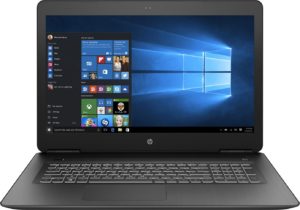
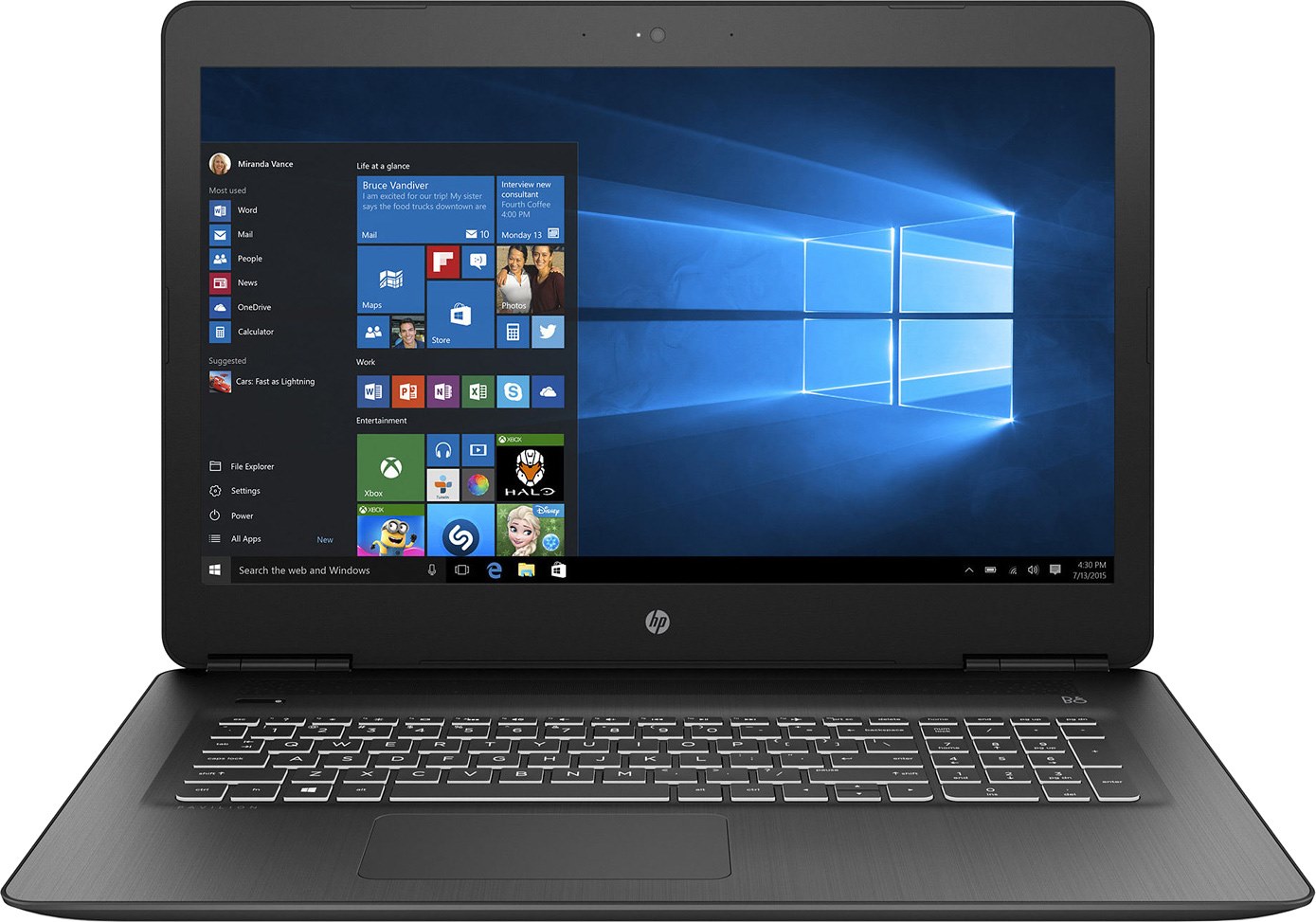



















This model doesn’t show up on HP’s US website, which has no 17″ Pavilion models listed.